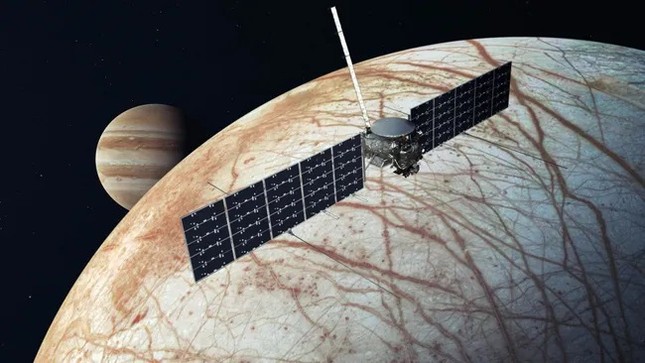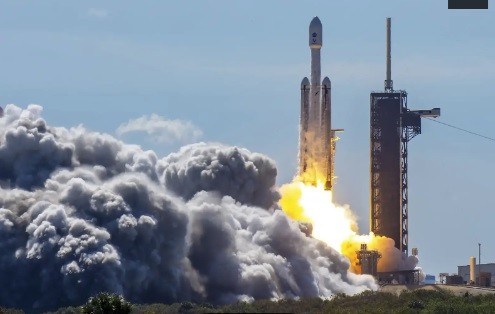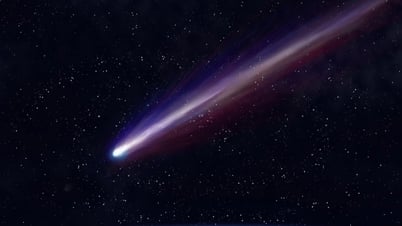TPO - NASA has just successfully launched Europa Clipper, the agency's largest interplanetary spacecraft ever, the size of a basketball court, into space and is now headed to Jupiter's icy moon Europa.
 |
Simulation of Europa Clipper flying past Europa as it orbits Jupiter (Image: NASA/JPL-Caltech) |
"Europa Clipper has begun its first journey to an ocean world beyond Earth," said NASA Administrator Bill Nelson.
The spacecraft lifted off on October 14 atop a SpaceX Falcon Heavy rocket from NASA's Kennedy Space Center in Florida, the US. It was originally scheduled to launch on October 10, but the mission was postponed due to Hurricane Milton.
When Europa Clipper arrives in 2030, the probe will study the ocean hidden beneath the moon's icy crust to determine whether the ocean is habitable and whether it has the potential to support life.
How big is Europa Clipper?
With its solar panels spread out, the orbiter is about 30 meters wide, larger than a basketball court. It is about 5 meters tall, according to NASA. These giant arrays are needed to collect solar energy to power the spacecraft when it reaches Europa, about 760 million kilometers from the sun.
How long will it take for Europa Clipper to reach Jupiter?
According to NASA's Jet Propulsion Laboratory (JPL), the spacecraft will take 5.5 years and travel 2.9 billion kilometers to Europa, Jupiter's fourth-largest moon. It will fly close to Mars for a "gravity assist" in February 2025, before returning to Earth for a December 2025 orbit to Jupiter. Europa Clipper will reach the giant planet and Jupiter's moons in June 2030.
Once there, the probe will fly by several of Jupiter's moons before making its first flyby of Europa in spring 2031. In total, Europa Clipper will make 49 flybys of Europa.
What is the purpose of Europa Clipper?
 |
Europa Clipper was successfully launched on October 14. |
The Europa Clipper mission is to dive below Europa's icy surface to search for key signs of habitable conditions. According to NASA, these include water, organic matter, essential chemical building blocks, sources of chemical energy below the surface, and signs of stable conditions.
Scientists believe Europa has a vast saltwater ocean that contains twice as much water as Earth's oceans — even though its moon is only a quarter of Earth's size. Because of this water, scientists consider Europa to be one of the most likely places in the solar system to find habitable conditions.
Scientists are still unsure about the thickness of Europa’s icy crust, so one of Europa’s main scientific goals is to determine this and find out the composition of the ice and vast ocean beneath it. These findings could give scientists clues about where in the universe potential life might be found.
“By exploring the unknown, Europa Clipper will help us better understand the potential for life not only in our solar system but also on billions of moons and planets beyond the Sun,” Nelson notes.
However, Europa Clipper will not directly search for signs of alien life in the moon's ocean.
How much does the Europa Clipper cost?
Europa Clipper cost about $3.8 billion to build and launch, and will cost another $1.2 billion to operate until it completes its core mission in 2034, according to the Planetary Society. The spacecraft carries a collection of advanced instruments that account for some of that cost.
The nine instruments include an array of cameras to observe the moon in visible and infrared light; a spectrometer and spectrometer to detect Europa's composition; instruments to monitor gravity, magnetic fields, and plasma; radar to look below the surface; and instruments to perform chemical analysis.
The instruments are housed in a vault lined with aluminum and titanium to protect them from the extremely high levels of radiation around Jupiter, which JPL says is the second highest in the entire solar system — second only to the sun.
Will the Europa Clipper land on Europa?
The spacecraft won’t land on Europa. Instead, it will stay in an elliptical orbit around Jupiter, which will help it survive the radiation levels that exist closer to Jupiter and Europa. At the end of its life, Europa Clipper will likely “deorbit,” meaning it will intentionally crash into the surface of Ganymede—Jupiter’s and the solar system’s largest moon.
According to Live Science
Source: https://tienphong.vn/nasa-phong-thanh-cong-europa-clipper-tau-vu-tru-lien-hanh-tinh-lon-nhat-tu-truoc-den-nay-post1682960.tpo


![[Photo] Determining the pairs in the team semi-finals of the National Table Tennis Championship of Nhan Dan Newspaper](https://vphoto.vietnam.vn/thumb/1200x675/vietnam/resource/IMAGE/2025/5/21/eacbf7ae6a59497e9ae5da8e63d227bf)
![[Photo] Prime Minister Pham Minh Chinh attends the groundbreaking ceremony of Trump International Hung Yen Project](https://vphoto.vietnam.vn/thumb/1200x675/vietnam/resource/IMAGE/2025/5/21/ca84b87a74da4cddb2992a86966284cf)

![[Photo] Prime Minister Pham Minh Chinh receives Rabbi Yoav Ben Tzur, Israeli Minister of Labor](https://vphoto.vietnam.vn/thumb/1200x675/vietnam/resource/IMAGE/2025/5/21/511bf6664512413ca5a275cbf3fb2f65)
























































































Comment (0)